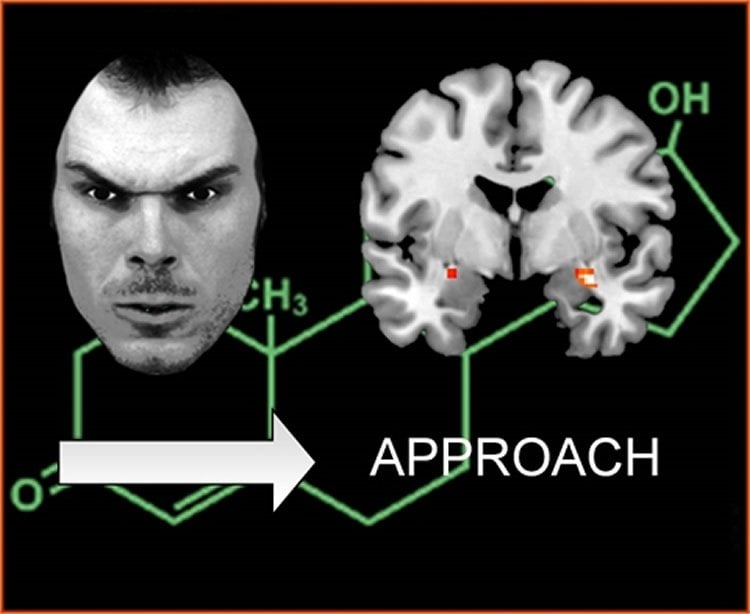New vision on amygdala after study on testosterone and fear.
The activity of the emotion centres in the brain, the amygdala, is influenced by motivation rather than by the emotions themselves. This can be concluded from research carried out at Radboud University into the hormone testosterone. Testosterone increases amygdala activity in a person who is approaching a socially threatening situation and decreases the activity when such a situation is avoided.
It was already known that the amygdala response to images of angry faces was stronger in a person who had received testosterone. This new study shows that this only happens when people approach angry faces and not when they avoid them.
Testosterone or placebo
In a double-blind, placebo-controlled study, 54 young healthy women were given 0.5 mg of testosterone (or a placebo) four hours before a brain scan. This dosage is much lower than, for example, that used for a sex change treatment, or as a supplement for sportspeople, but it is sufficient to have a measurable effect on brain activity.
Happy or angry
While in the fMRI-scanner the participants were shown photos of happy and angry faces and were asked to give a sign of rejection (away from) or of approach (towards). People normally have less of a problem approaching someone who looks friendly than someone who looks angry: making a sign of approach when seeing an angry face actually requires more effort and control. The reaction times confirmed this as they were longer when an angry face was approached.

Meanwhile the researchers measured amygdala activity. The actvity was greater in women who had been given testosterone only when they approached angry faces, and only then.
Amygdala for motivation
“Previous research has shown that higher testosterone levels lead to an intensified amygdala reaction in the presence of angry faces,” says Karin Roelofs, Professor of Experimental Psychopathology at the Donders Institute for Brain, Cognition and Behaviour and the Behavioural Science Institute, Radboud University. “Those earlier investigations looked at what happens in non-active situations and not during action. The focus was on what you should do if you see an angry face.
It seems that testosterone facilitates social approach by specifically activating the amygdala only if social approach is desired. This is interesting for two reasons. It explains previous research that showed that testosterone makes approaching a social threat easier. Even more important, it shows that the amygdalae are not necessarily linked to dealing with emotions, but rather to motivation. Many studies forget to look at motivation. We are the first to demonstrate that the impact of testosterone on amygdala response depends on the motivational context.”
Also in cases of social anxiety?
“We’re now going to repeat this study in people with social anxieties. We have already discovered that these people have lower testosterone levels. We are going consider how we can apply these results with testosterone to improving the treatment for anxiety disorders.”
Source: Radbound University
Image Credit: The image is credited to the researchers and is adapted from the press release
Original Research: Full open access research for “Testosterone biases the amygdala towards social threat approach” by Sina Radke, Inge Volman, Pranjal Mehta, Veerle van Son, Dorien Enter, Alan Sanfey, Ivan Toni, Ellen R. A. de Bruijn, and Karin Roelofs in Science Advances. Published online June 12 2015 doi:10.1126/sciadv.1400074
Abstract
Testosterone biases the amygdala towards social threat approach
Testosterone enhances amygdala reactions to social threat, but it remains unclear whether this neuroendocrine mechanism is relevant for understanding its dominance-enhancing properties; namely, whether testosterone biases the human amygdala toward threat approach. This pharmacological functional magnetic-resonance imaging study shows that testosterone administration increases amygdala responses in healthy women during threat approach and decreases it during threat avoidance. These findings support and extend motivational salience models by offering a neuroendocrine mechanism of motivation-specific amygdala tuning.
“Testosterone biases the amygdala towards social threat approach” by Sina Radke, Inge Volman, Pranjal Mehta, Veerle van Son, Dorien Enter, Alan Sanfey, Ivan Toni, Ellen R. A. de Bruijn, and Karin Roelofs in Science Advances. Published online June 12 2015 doi:10.1126/sciadv.1400074






